Microstructure and Texture Characterization of Duplex Stainless Steel Joints Welded by Alternating Magnetic Field-Assisted Hybrid Laser-GMAW Welding
Abstract
:1. Introduction
2. Experimental Procedures
2.1. Materials and Welding Process
2.2. Microstructural Characterization
3. Results and Discussion
3.1. Effect of a Transverse Alternating Magnetic Field on the Weld Microstructure
3.1.1. Effect of an Alternating Magnetic Field on the Microstructure Characteristics of a Welded Joint of 2205 Duplex Stainless Steel
3.1.2. Study on the Distribution of Welded Joint Elements
3.1.3. XRD Analysis of Weld
3.2. Effect of a Transverse Alternating Magnetic Field on the Grain Orientation and Texture of the Weld Microstructure
3.2.1. Two-Phase Orientation and Texture Distribution of Welds
3.2.2. Grain Boundary Orientation Difference and Grain Size of the Weld
3.3. Mechanism Analysis of the Effect of an Alternating Magnetic Field on the Tissue Structure
4. Conclusions
- (1)
- Mo improved the pitting resistance of 2205 duplex stainless steel and promoted the precipitation of the phase. Thus, Mo can maintain the uniformity of the two phases when matched with the content of Ni and N;
- (2)
- SEM and EDS analysis showed that the application of a 20 mT alternating magnetic field improved the uniform distribution of alloy elements in the two phases, promoted the diffusion and dissolution of Ni and N elements to γ phase, facilitated the transition from the α to γ phase, and reduced the precipitation of Cr2N;
- (3)
- The EBSD results of WM showed that the austenite content in WM increased by 6.5% after applying a 30 mT alternating magnetic field, further precipitating WA. Then, the WM texture strength was increased, and the maximum orientation densities of α and γ phases were increased by 5.12 and 0.89 compared to no magnetic field. The ferrite texture distribution shifted to the α orientation line and a strong {111} <110> texture appeared. The austenite texture was concentrated under the action of the alternating magnetic field, and the Cubic texture, copper texture, and goss texture were found under the alternating magnetic field of 30 mT;
- (4)
- The effect of an alternating magnetic field promoted the transformation of austenite Σ3 twin boundary to HABs, and the dynamic recrystallization of the ferrite phase reduced LABs. In addition, the average grain size of the α-phase and γ-phase under a 30 mT alternating magnetic field was reduced to 5.58 μm and 6.2 μm, respectively.
Author Contributions
Funding
Institutional Review Board Statement
Informed Consent Statement
Data Availability Statement
Conflicts of Interest
References
- Jebaraj, A.V.; Ajaykumar, L. Influence of microstructural changes on impact toughness of weldment and base metal of duplex stainless steel AISI 2205 for low temperature applications. Procedia Eng. 2013, 64, 656–666. [Google Scholar]
- Mirakhorli, F.; Ghaini, F.M.; Torkamany, M. Development of weld metal microstructures in pulsed laser welding of duplex stainless steel. J. Mater. Eng. Perform. 2012, 21, 2173–2176. [Google Scholar] [CrossRef]
- Tan, H.; Wang, Z.Y.; Jiang, Y.M.; Yang, Y.Z.; Deng, B.; Song, H.M.; Li, J. Influence of welding thermal cycles on microstructure and pitting corrosion resistance of 2304 duplex stainless steels. Corros. Sci. 2012, 55, 368–377. [Google Scholar] [CrossRef]
- Zhu, Z.W.; Ma, X.Q.; Wang, C.M.; Mi, G.Y.; Zheng, S.Y. The metallurgical behaviors and crystallographic characteristic on macro deformation mechanism of 316 L laser-MIG hybrid welded joint. Mater. Des. 2020, 194, 108893. [Google Scholar] [CrossRef]
- Ma, S.C.; Zhao, Y.; Zou, J.S.; Yan, K.; Liu, C. The effect of laser surface melting on microstructure and corrosion behavior of friction stir welded aluminum alloy 2219. Opt. Laser Technol. 2017, 96, 299–306. [Google Scholar] [CrossRef]
- Zhao, Y.; Yang, Q.L.; Huang, J.; Zou, J.S.; Wu, Y.X. Droplet transfer and weld geometry in laser welding with filling wire. Int. J. Adv. Manuf. Technol. 2017, 90, 2153–2161. [Google Scholar] [CrossRef]
- Zhao, Y.; Ma, S.C.; Huang, J.; Wu, Y.X. Narrow-gap laser welding using filler wire of thick steel plates. Int. J. Adv. Manuf. Technol. 2017, 1, 1–8. [Google Scholar] [CrossRef]
- Pu, J.H.; Zhao, Y.; Jiang, Y.M.; Zou, J.S.; Song, S.M. Influence of wire feeding speed on the melting behavior and formation of narrow-gap joint by laser welding with filler wire. J. Laser Appl. 2020, 32, 032007. [Google Scholar] [CrossRef]
- Chen, R.; Jiang, P.; Shao, X.Y.; Mi, G.Y.; Wang, C.M. Analysis of crack tip transformation zone in austenitic stainless steel laser-MIG hybrid welded joint. Mater. Charact. 2017, 132, 260–268. [Google Scholar] [CrossRef]
- Liu, S.; Liu, F.; Xu, C. Experimental investigation on arc characteristic and droplet transfer in CO2 laser-MAG hybrid welding. Int. J. Heat Mass Transf. 2013, 62, 604–611. [Google Scholar] [CrossRef]
- Cai, B.H.; Fu, J.; Zhao, Y.; Chen, F.G.; Qin, Y.H.; Song, S.M. Effect of Alternating Magnetic Field on Arc Plasma Characteristics and Droplet Transfer during Narrow Gap Laser-MIG Hybrid Welding. Metal 2021, 11, 1712. [Google Scholar] [CrossRef]
- Cho, W.; Woizeschke, P. Analysis of moltenpool behavior with buttonhole formation in laser keyhole welding of sheet metal. Int. J. Heat Mass Transf. 2020, 152, 11–28. [Google Scholar] [CrossRef]
- Zhao, Y.; Wang, W.Y.; Yan, K.; Liu, C.; Zou, J.S. Microstructure and properties of Cu/Ti laser welded joints. J. Mater. Process. Technol. 2018, 257, 244–249. [Google Scholar] [CrossRef]
- Luo, J.; Luo, Q.; Wang, X.; Wang, X. EMS-CO2 welding: A new approach to improve droplet transfer characteristics and welding formation. Mater. Manuf. Process. 2010, 25, 1233–1241. [Google Scholar] [CrossRef]
- Reis, R.P.; Scotti, A.; Norrish, J.; Cuiuri, D. Investigation on welding arc interruptionsin the presence of magnetic fields: Arc length, torch angle and current pulsing frequency influence. IEEE Trans. Plasma Sci. 2013, 41, 133–139. [Google Scholar] [CrossRef] [Green Version]
- Chen, R.; Jiang, P.; Shao, X.Y.; Mi, G.Y.; Wang, C.M. Enhancement of fatigue resistance for 316L welds produced by magnetic field assisted laser-MIG hybrid welding. J. Mater. Process. Tech 2018, 254, 114–123. [Google Scholar] [CrossRef]
- Chen, R.; Jiang, P.; Shao, X.Y.; Mi, G.Y.; Wang, C.M.; Geng, S.N. Improvement of low-temperature impact toughness for 304 weld joint produced by laser-MIG hybrid welding under magnetic field. J. Mater. Process. Tech 2017, 247, 306–314. [Google Scholar] [CrossRef]
- Zhu, Z.W.; Ma, X.Q.; Wang, C.M.; Mi, G.Y. Grain refinement and orientation alternation of 10 mm 316L welds prepared by magnetic field assisted narrow gap laser-MIG hybrid welding. Mater. Charact. 2020, 164, 110311. [Google Scholar]
- Zhu, Z.W.; Ma, X.Q.; Wang, C.M.; Mi, G.Y.; Hu, C.J.; Zheng, S.Y. Effect of microstructure and microtexture modified by magnetic field on as-weld notch bending performance. J. Mater. Process. Tech 2021, 289, 116958. [Google Scholar] [CrossRef]
- Renata, M.S.; Daniella, G.R.; Maria, L.D.S.; Dagoberto, B.S. Martensite reversion and strain hardening of a 2304 lean duplex stainless steel subjected to cold rolling and isochronous annealing at low temperatures. J. Mater. Res. Technol. 2022, 16, 168–186. [Google Scholar]
- Rodrigues, D.G.; de Alcantara, C.M.; de Oliueira, T.R.; Gonzalez, B.M. The effect of grain size and initial texture on microstructure, texture, and formability of Nb stabilized ferritic stainless steel manufactured by two-step cold rolling. J. Mater. Res. Technol. 2019, 8, 4151–4162. [Google Scholar] [CrossRef]
- Lü, Q.G.; Chen, G.N.; Zhou, J.C. Textures inhot rolled steel sheet. Iron Steel Vanadium Titan. 2001, 22, 1–7. [Google Scholar]
- Zhu, Z.W.; Ma, X.Q.; Mi, G.Y.; Wang, C.M. Electron microscopy study of laser weldedGH909 superalloy joint. J. Mater. Res. Technol. 2020, 9, 15525–15536. [Google Scholar] [CrossRef]

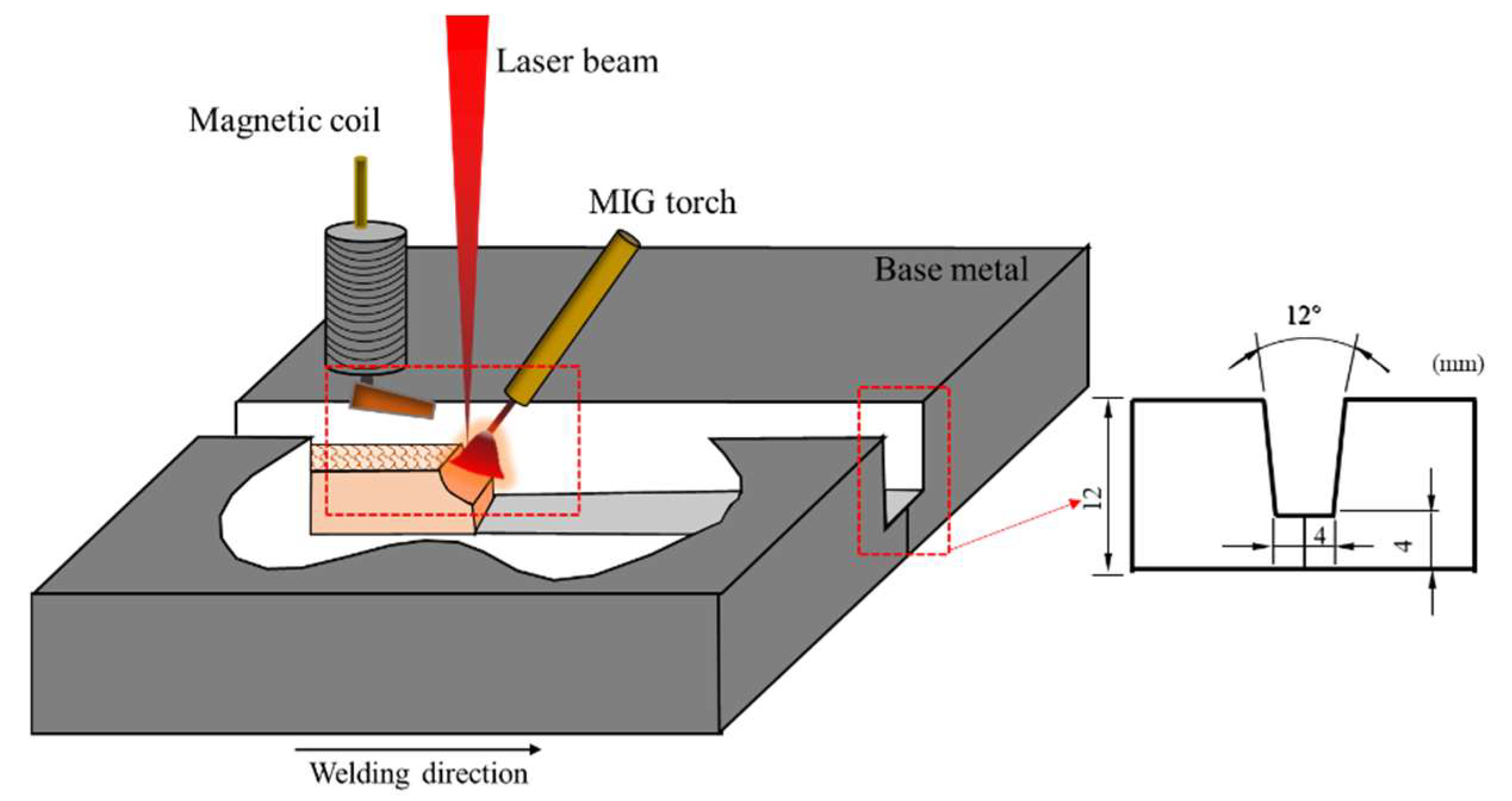
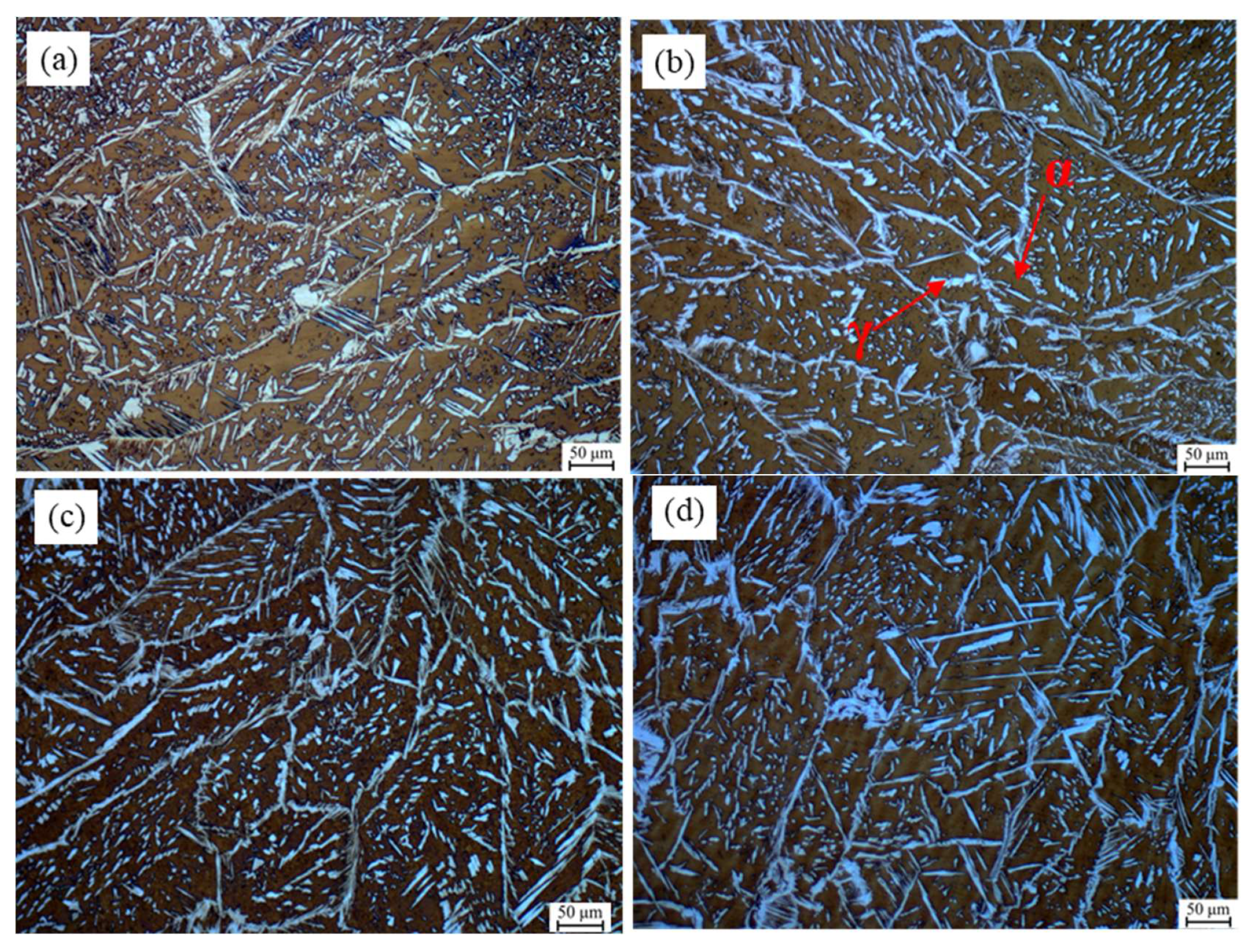
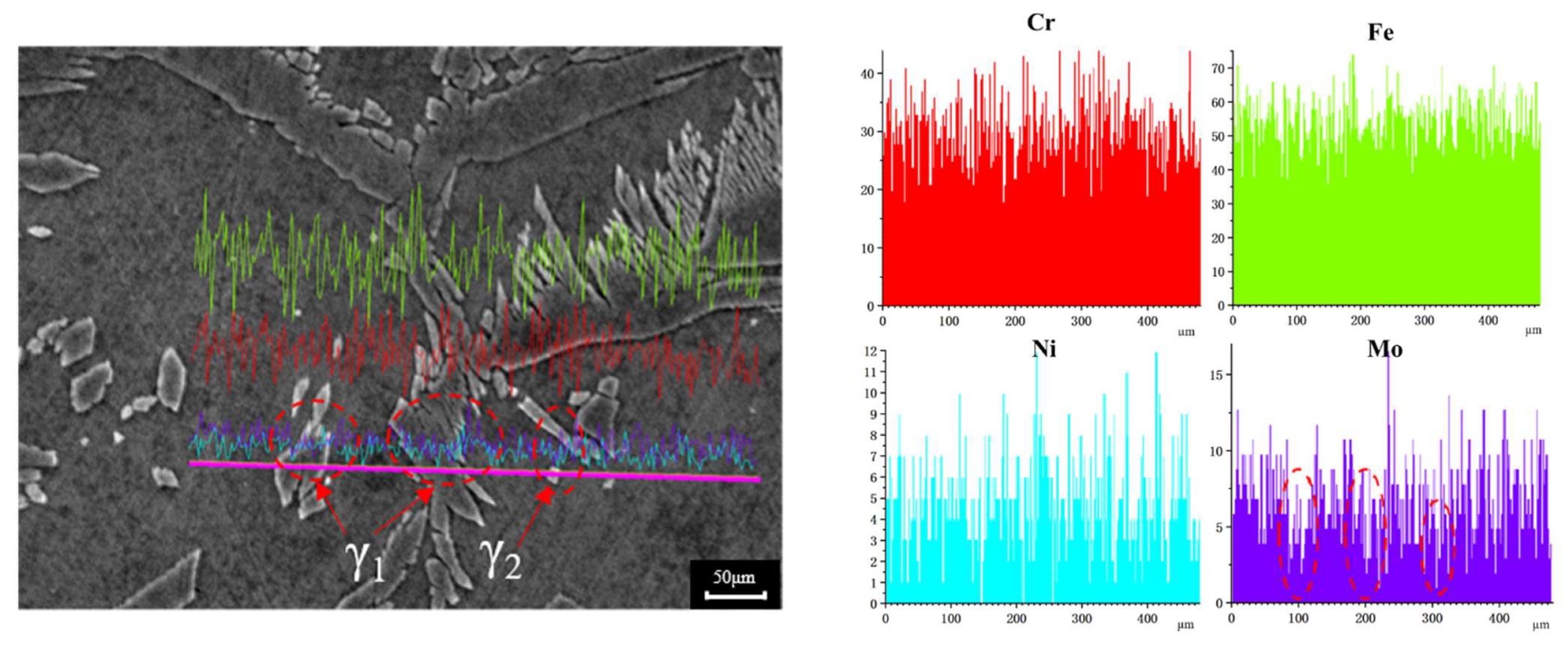


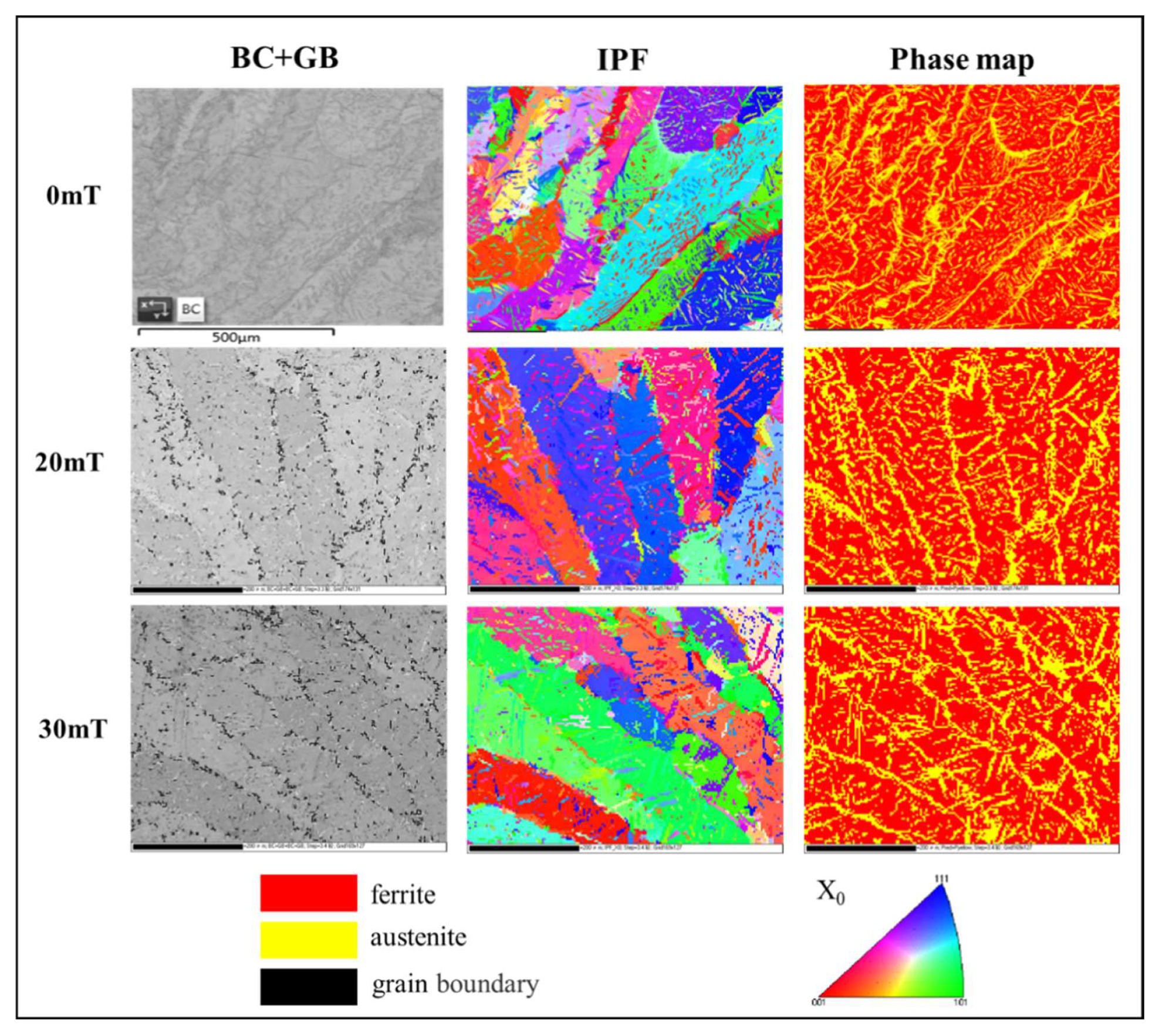

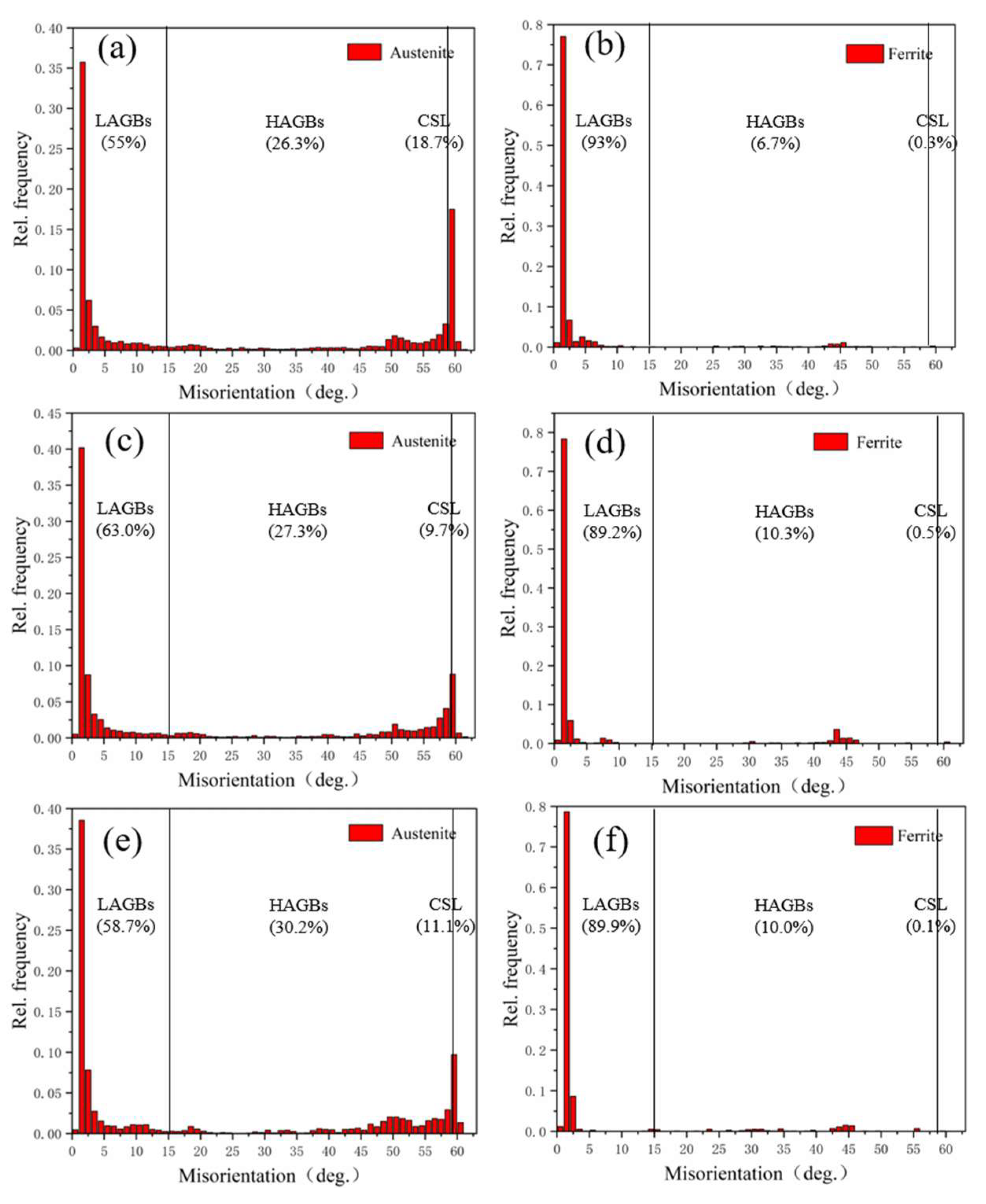
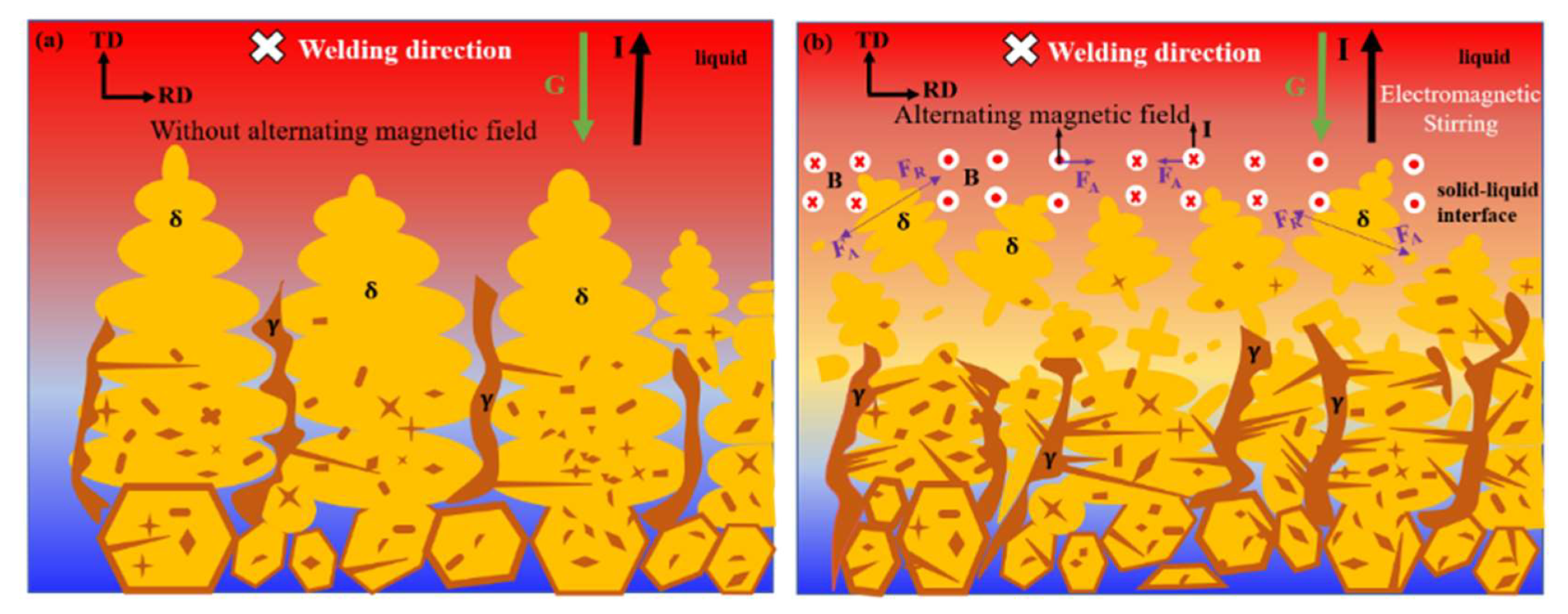
| Material | C | P | S | Cr | Ni | N | Mo | Mn | Si | Fe |
|---|---|---|---|---|---|---|---|---|---|---|
| 2205 ER2209 | 0.024 0.019 | 0.023 0.016 | 0.001 0.0008 | 22.39 22.59 | 5.68 9.41 | 0.17 0.16 | 3.13 3.10 | 1.38 1.66 | 0.39 0.17 | balance balance |
| The Alternating Magnetic Field Parameters | No Magnetic Field | f = 50 Hz B = 10 mT | f = 50 Hz B = 20 mT | f = 50 Hz B = 30 mT |
|---|---|---|---|---|
| γ (%) | 39.1 | 40.7 | 43.4 | 44.6 |
| α (%) | 60.9 | 59.3 | 56.6 | 55.4 |
| Position | Phase | Cr | Ni | Mo | N |
|---|---|---|---|---|---|
| BM | α | 24.41 | 4.80 | 4.67 | 0.10 |
| γ | 22.13 | 6.94 | 2.34 | 0.79 | |
| WM (0 mT) | α | 23.65 | 6.54 | 6.16 | 0.08 |
| γ | 23.06 | 6.91 | 4.02 | 0.74 | |
| WM (20 mT) | α | 23.29 | 6.96 | 5.87 | 0.20 |
| γ | 24.34 | 7.32 | 4.29 | 0.80 |
Publisher’s Note: MDPI stays neutral with regard to jurisdictional claims in published maps and institutional affiliations. |
© 2022 by the authors. Licensee MDPI, Basel, Switzerland. This article is an open access article distributed under the terms and conditions of the Creative Commons Attribution (CC BY) license (https://creativecommons.org/licenses/by/4.0/).
Share and Cite
Fu, J.; Rao, Z.; Zhao, Y.; Zou, J.; Liu, X.; Pan, Y. Microstructure and Texture Characterization of Duplex Stainless Steel Joints Welded by Alternating Magnetic Field-Assisted Hybrid Laser-GMAW Welding. Materials 2022, 15, 8741. https://doi.org/10.3390/ma15248741
Fu J, Rao Z, Zhao Y, Zou J, Liu X, Pan Y. Microstructure and Texture Characterization of Duplex Stainless Steel Joints Welded by Alternating Magnetic Field-Assisted Hybrid Laser-GMAW Welding. Materials. 2022; 15(24):8741. https://doi.org/10.3390/ma15248741
Chicago/Turabian StyleFu, Juan, Zhipeng Rao, Yong Zhao, Jiasheng Zou, Xin Liu, and Yanfei Pan. 2022. "Microstructure and Texture Characterization of Duplex Stainless Steel Joints Welded by Alternating Magnetic Field-Assisted Hybrid Laser-GMAW Welding" Materials 15, no. 24: 8741. https://doi.org/10.3390/ma15248741





